Building your root cellar 10 feet underground leverages the earth's natural temperature control, maintaining a steady 52°F (11°C) year-round. You'll benefit from consistent conditions that protect your stored produce from extreme surface temperatures and seasonal fluctuations. At this depth, you won't need electricity for cooling, as the soil acts as a natural insulator, keeping temperatures between 32-40°F (0-4°C) and humidity at 85-95% – perfect for preserving fruits and vegetables. The deeper placement also safeguards against frost heave and provides ample storage space for hundreds of pounds of food. There's much more to discover about maximizing your root cellar's natural efficiency.
Temperature Stability Below Ground
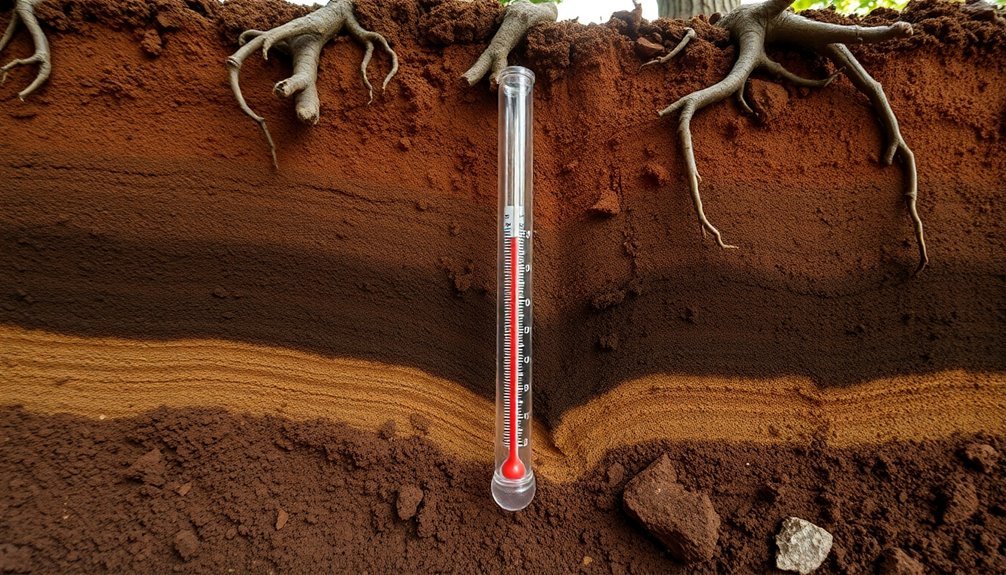
Maintaining a consistent temperature is one of the most compelling reasons to build a root cellar underground. When you dig down 10 feet, you'll tap into the earth's natural temperature stability, which hovers around 52°F (11°C). This depth protects your stored produce from extreme surface temperatures, keeping your cellar cool in summer and preventing freezing in winter.
Below the frost line, you'll find that the earth acts as a powerful insulator, creating an environment where temperature fluctuations are minimal. This stability is essential for storing fruits and vegetables, as it helps maintain the ideal storage range of 32-40°F (0-4°C). Drainage systems are crucial for preventing water damage and maintaining optimal storage conditions. You won't have to worry about daily or seasonal temperature swings affecting your produce.
The earth's natural insulation properties also help create distinct storage zones within your cellar, allowing you to store different types of produce according to their temperature preferences. This consistent environment prevents premature sprouting and reduces spoilage by controlling ethylene gas buildup.
Combined with the earth's natural moisture, which maintains proper humidity levels, you'll create perfect conditions for long-term food storage that mimics autumn's preserving environment.
Natural Energy Conservation Benefits
Your root cellar's biggest advantage comes from Earth's remarkable natural cooling power, which maintains consistent temperatures without any electricity or mechanical systems.
You'll experience steady climate control throughout the year, as the ground's natural insulation keeps your cellar cool in summer and prevents freezing in winter.
You're tapping into a zero-cost cooling system that has worked for centuries, making your root cellar an environmentally conscious choice for food storage. Ancient civilizations like the Inuit communities demonstrated this method's effectiveness by storing meat and fish in deep, snow-covered pits.
Earth's Natural Cooling Power
Nature's brilliance shines through in the earth's remarkable ability to regulate temperature. When you build your root cellar 10 feet down, you're tapping into the earth's natural cooling power, where soil acts as a poor heat conductor, maintaining consistently cool temperatures throughout the year.
You'll find that the deep-earth temperature remains largely unaffected by surface fluctuations, providing reliable natural insulation. This underground environment naturally maintains temperatures between 32-50°F, creating perfect conditions for long-term food storage.
You'll benefit from the earth's natural humidity levels, which maintain the ideal 85-95% moisture content needed to keep your produce fresh. This eliminates the need for artificial humidification systems while preserving the flavor, texture, and nutritional value of your stored vegetables.
When you build on a north-facing hillside, you'll maximize these natural cooling properties.
Temperature Consistency Year-Round
Through careful temperature management, a properly built root cellar maintains a remarkably stable environment year-round. At 10 feet deep, you'll find that soil temperatures remain consistently cool, typically hovering between 32-40°F (0-4°C), which is perfect for preserving your harvests. This natural stability means you won't need electricity or mechanical cooling systems to maintain optimal storage conditions.
| Temperature Benefits | Storage Impact |
|---|---|
| Minimal Fluctuation | Prevents produce sprouting and decay |
| Year-round Stability | Extends storage life by months |
| Natural Insulation | Maintains freshness without energy costs |
The earth's natural insulation at this depth provides significant advantages for your food storage. You'll notice that temperature variations are much less pronounced than in above-ground storage, which helps prevent spoilage and maintains produce quality. This consistency is particularly valuable during extreme weather conditions, as your root cellar will stay cool during summer heat waves and prevent freezing during winter cold snaps. By utilizing these natural temperature properties, you're not just storing food efficiently – you're also reducing your energy consumption and environmental impact while preserving your harvest's nutritional value.
Zero-Cost Climate Control
One of the most compelling advantages of a root cellar lies in its completely cost-free climate control system.
You'll tap into the earth's natural insulation properties, which maintain stable temperatures and humidity levels without using any electricity. By positioning your root cellar 10 feet below ground, you're accessing nature's most efficient climate control mechanism.
You'll benefit from the earth's remarkable ability to regulate both temperature and moisture consistently, creating ideal storage conditions for your produce. The natural humidity levels of 85-95% prevent your vegetables from drying out while maintaining their nutritional value and flavor.
Here's what makes this zero-cost system so effective:
- The earth's natural insulation eliminates the need for artificial cooling or heating systems, considerably reducing your carbon footprint.
- Underground placement maintains consistent temperatures year-round, working effectively in both cold and warm climates.
- Natural moisture from the surrounding soil creates perfect humidity conditions without requiring humidifiers or additional equipment.
Frost Line Protection
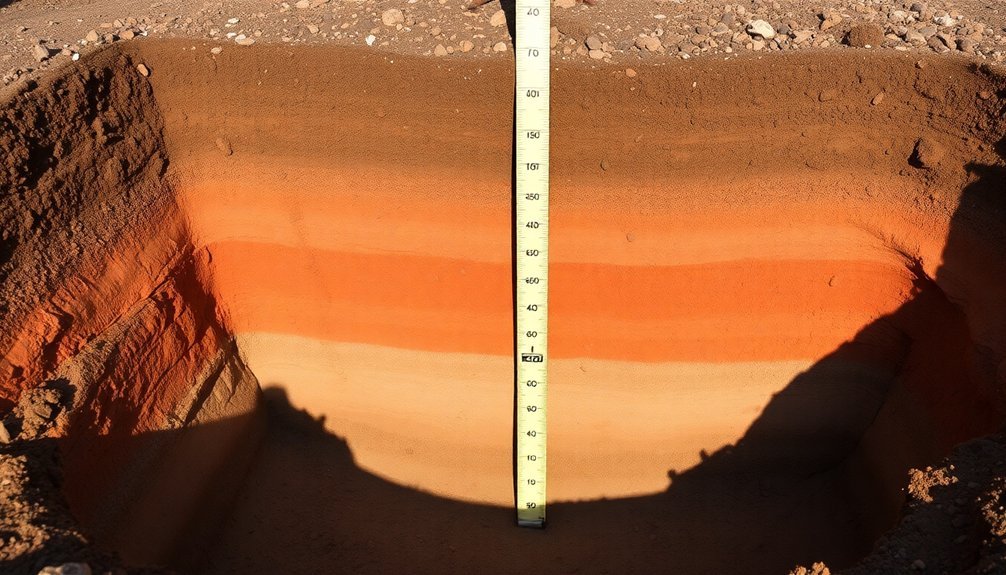
You'll need to dig your root cellar's foundation below the frost line, which can extend more than 4 feet deep in many regions, to protect the structure from seasonal freeze damage.
Building at this depth takes advantage of the earth's natural insulation properties, keeping temperatures consistently between 32-50°F throughout the year.
The soil's stable temperature and high moisture content create ideal conditions for long-term food storage while protecting your cellar's structural integrity from frost heave.
Depth Beyond Freezing Point
Root cellars rely heavily on proper depth placement to maintain ideal storage conditions for your preserved foods. When you're planning your root cellar, you'll need to dig beyond the frost line, which typically sits 36 to 48 inches below ground. This depth guarantees your stored food won't freeze during winter months and maintains consistent temperatures year-round.
You'll want to take into account your specific climate when determining the perfect depth. In warmer regions, you might need to dig deeper to achieve cooler temperatures, while in colder areas, you'll need to avoid hitting permafrost. The key is finding the sweet spot that balances temperature control with practical access.
Essential benefits of proper depth placement include:
- Protection from freezing temperatures and extreme weather fluctuations
- Natural temperature regulation through earth's insulating properties
- Prevention of moisture-related issues and flooding
Remember to incorporate proper drainage and waterproofing measures, regardless of depth. You'll also need to design a practical entrance system, such as cellar-door style access with sturdy stairs, guaranteeing you can easily reach your stored goods while maintaining the cellar's temperature-controlling benefits.
Below-Ground Temperature Stability
Natural temperature stability beneath the frost line makes underground root cellars exceptionally effective for long-term food storage. When you dig deeper than the frost line, you'll find the earth maintains a consistent temperature of around 52°F (11°C), creating ideal conditions for preserving vegetables and fruits.
This natural temperature regulation isn't affected by surface weather fluctuations, providing reliable storage conditions year-round.
The earth's natural moisture content helps maintain ideal humidity levels in your root cellar, particularly if you incorporate a dirt floor. You can spread gravel over packed earth to prevent excess moisture while preserving beneficial humidity that keeps your produce from drying out.
Your underground cellar needs strong construction to handle soil weight and moisture. It's essential to position the floor higher than the surrounding ground and install proper drainage to prevent water damage.
When building, you'll want to use wood that's specifically designed for ground contact and non-toxic treatments for the walls and floor. If your cellar includes any above-ground portions, make sure to insulate them well to maintain the stable environment that makes underground storage so effective.
Seasonal Temperature Protection
When building a root cellar, proper frost line protection serves as your primary defense against seasonal temperature extremes.
You'll need to dig below the frost line, typically 36 to 48 inches deep, though it's wise to go 25 percent deeper than your local average frost depth for added protection.
Your root cellar's structural integrity depends on proper insulation and drainage systems.
Install insulation along exterior walls extending below the frost line, and guarantee your cellar floor sits higher than the outside soil level.
You'll want to incorporate gravel and drain pipes to manage water effectively and prevent freezing-related damage.
Key considerations for frost line protection include:
- Maintaining a balance between depth requirements to avoid both freezing and permafrost issues
- Installing a double-door system to maintain consistent internal temperatures
- Implementing proper ventilation while preserving insulation integrity
For ideal protection, use weather-resistant materials and confirm your construction includes proper water management systems.
Remember that masonry walls require additional insulation, and all wood components should be treated with non-toxic preservatives suitable for underground use.
This thorough approach will help maintain stable temperatures year-round in your root cellar.
Ideal Humidity Management
In a root cellar, managing humidity levels is critical for preserving your stored vegetables. Most root crops and leafy vegetables need 90-95% relative humidity to stay fresh.
You'll find that a dirt floor naturally maintains better moisture levels compared to concrete or stone surfaces. If you need to boost humidity, you can sprinkle water on gravel laid over packed earth or place damp burlap bags on the floor.
You'll want to pack your vegetables in damp sawdust, sand, or moss to reduce surface evaporation, especially in basement root cellars that tend to be drier. A fuller cellar helps maintain higher humidity levels, so don't build a storage area that's too large.
However, you'll need to watch for excess moisture, which can cause mold growth and condensation problems, particularly in spring.
If you're building a dug-in root cellar, you'll benefit from the earth's natural moisture retention. Plant grass on the roof to prevent soil erosion and guarantee proper drainage around the structure.
Don't forget to install a thermometer and humidity gauge to monitor conditions, and consider using a dehumidifier if you're in a wet climate.
Ventilation and Air Flow Design
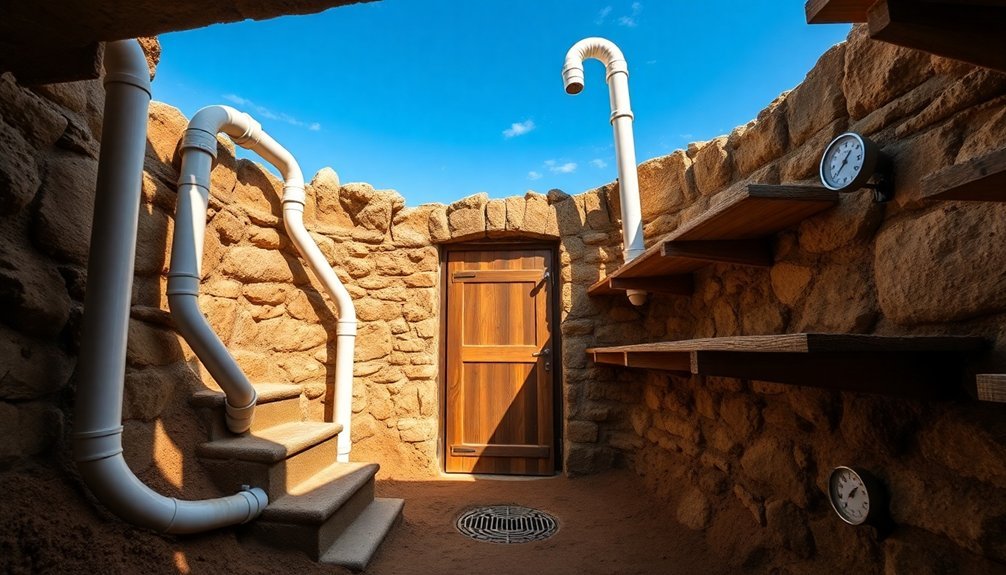
A properly designed ventilation system forms the backbone of any successful root cellar. You'll need to install two main components: a low-mounted air intake vent and a high-mounted outlet vent on opposite sides of your cellar. This setup creates a natural convection flow, where cool air enters through the bottom and warm air exits through the top.
For effective air circulation, you'll want to use 4-inch diameter ductwork and protect your vents with screens to keep pests out. When installing storage units, remember to elevate your crates to allow air movement underneath.
The earth's natural insulation helps maintain stable temperatures, but you'll need to properly seal your duct installations with silicone caulk to prevent unwanted air leaks.
Your ventilation system should include:
- Adjustable dampers to regulate airflow during different seasons
- Wire mesh screens on both intake and outlet vents
- Vertical channels that direct air movement efficiently
Regular monitoring of your ventilation system helps manage humidity levels and removes ethylene gas produced by stored produce. You can adjust the vents seasonally to maintain ideal conditions and prevent condensation buildup, ensuring your root cellar remains an effective storage space year-round.
Space Maximization Advantages
Building your root cellar at a 10-foot depth reveals remarkable space maximization benefits that complement its ventilation system.
You'll find that this depth provides ample room to store hundreds of pounds of produce while maintaining ideal conditions for long-term preservation. The spacious underground environment lets you install multiple shelving units and storage areas, making it far more efficient than using several refrigerators or freezers.
You'll appreciate how the 10-foot depth creates a stable environment where temperature and humidity remain consistent throughout the seasons. This means you can store your entire garden harvest without worrying about fluctuating external weather conditions.
The natural insulation at this depth helps maintain temperatures between 32° to 40°F and humidity levels of 85-95%, creating perfect conditions for preserving your produce.
What's particularly advantageous is that you won't need electricity to maintain these conditions. The earth's natural temperature regulation does the work for you, making your root cellar completely self-sufficient.
This depth maximizes both storage capacity and energy efficiency, allowing you to store fresh produce year-round while remaining independent from external power sources.
Structural Support Elements
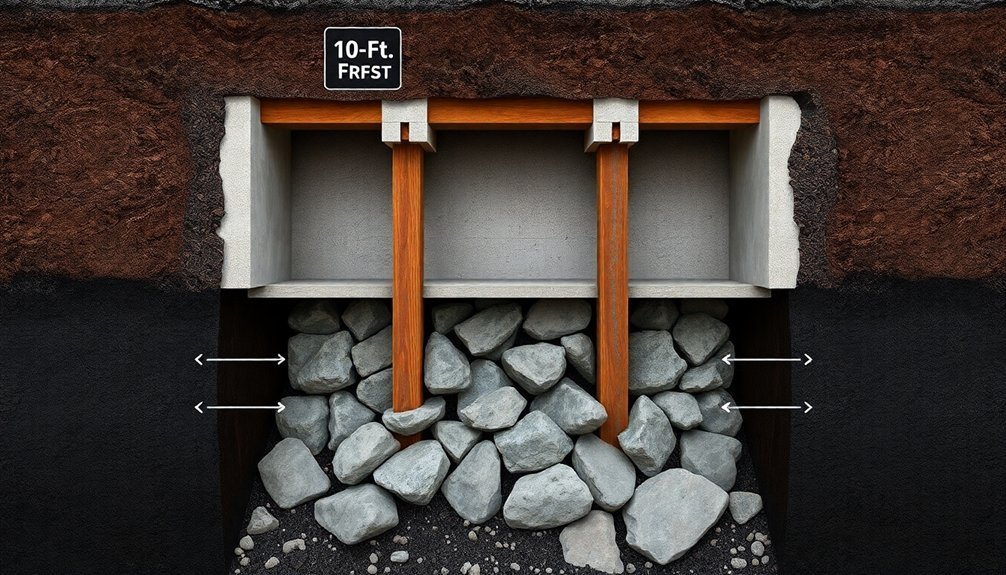
Your root cellar's stability depends on proper foundation load distribution, which you'll achieve through concrete footers poured at least 46 inches below the frost line.
You'll need to reinforce your walls with both horizontal and vertical rebar to handle the intense lateral pressure from surrounding soil.
Adding mortar mix with the correct ratio of sand, cement, and lime will strengthen your brick or concrete walls while ensuring they can withstand moisture and temperature fluctuations.
Foundation Load Distribution
Root cellar construction demands careful attention to foundation load distribution to guarantee long-term structural integrity. When you're building 10 feet down, the earth's weight creates significant pressure on your cellar's walls and floor. You'll want to make certain that this load is evenly distributed to prevent structural issues over time.
The soil surrounding your root cellar actually works in your favor, as it naturally distributes the pressure around the entire structure. If you're dealing with sandy ground, you'll need to establish a solid base using concrete or rock to prevent settling. A dirt floor isn't just traditional – it's practical, helping maintain proper humidity while supporting your stored items without requiring additional foundation work.
Here's what you'll need to focus on for proper load distribution:
- Install proper footers with poured concrete to create a stable base that prevents wall shifting.
- Use strategic backfilling techniques around the cellar walls to prevent uneven soil settlement.
- Make certain the floor's height is slightly elevated compared to the outside soil level for ideal drainage.
Remember that the weight of the earth covering your cellar also helps maintain consistent temperature and humidity, making proper load distribution essential for both structural integrity and functionality.
Wall Reinforcement Techniques
Strong walls serve as the backbone of any root cellar, and proper reinforcement techniques make the difference between a lasting structure and a failing one. When you're building 10 feet down, you'll need to implement multiple reinforcement methods to counter the intense earth pressure.
| Reinforcement Element | Purpose |
|---|---|
| Horizontal Rebar | Provides lateral strength every 12 inches |
| Vertical Rebar | Guarantees stability every 24 inches |
| Concrete Columns | Supports roof weight distribution |
| Angled Walls | Reduces direct pressure from soil |
Start by installing #4 rebar in a grid pattern, with horizontal pieces every foot and vertical pieces every two feet. You'll want to bend and secure the rebar into your forms before pouring concrete. For maximum stability, incorporate three concrete support columns and consider building your walls at a 45-degree angle to better distribute the soil's weight.
Don't rely on a single material – combine cement blocks with pressure-treated timbers for additional support. When using concrete blocks, fill the cores with concrete and rebar for enhanced structural integrity. Finally, create an earthen berm against the exterior walls to provide natural support and insulation while reducing direct pressure on the structure.
Year-Round Storage Solutions
Establishing a reliable year-round storage system starts with understanding how root cellars maintain consistent conditions regardless of external weather.
You'll find that a properly constructed root cellar, built 10 feet below ground, provides stable temperatures between 32-40 degrees Fahrenheit and humidity levels of 80-90% throughout all seasons.
To maximize your storage potential, you'll want to implement these essential features:
- Install adjustable ventilation systems that you can open or close based on seasonal needs, helping maintain ideal conditions
- Create organized storage zones with shelves and bins to separate different produce types and maximize space efficiency
- Use natural moisture-retention materials like sawdust or peat moss to maintain consistent humidity levels
You don't need electricity to keep your produce fresh when you've got a well-designed root cellar.
The earth's natural insulation at this depth helps maintain perfect storage conditions year-round.
With regular monitoring of temperature and humidity levels, you can store more food than multiple refrigerators would hold.
Remember to adjust your ventilation during winter months and keep the dirt floor slightly damp to maintain proper humidity.
This setup guarantees you'll have access to fresh produce throughout the year while enhancing your self-sufficiency.
Earth's Natural Insulation Properties
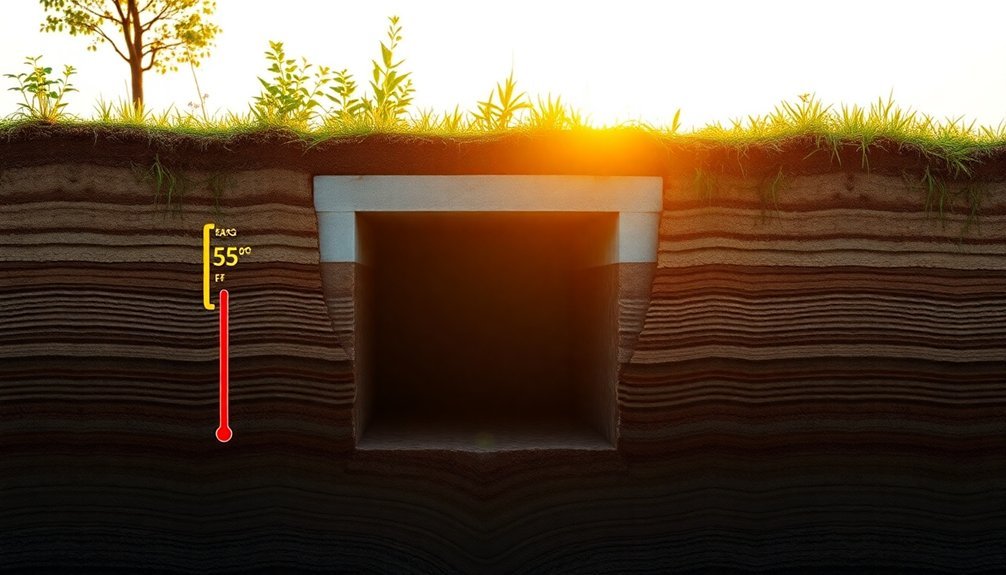
Inside the earth's protective embrace, natural insulation properties create ideal conditions for food preservation. You'll find that soil maintains a remarkably stable temperature between 32-40°F (0-4°C), acting as a natural thermal regulator that shields your stored produce from external temperature fluctuations.
When you build your root cellar, you're taking advantage of the earth's impressive moisture control capabilities. The ground naturally maintains humidity levels between 85-95%, which is perfect for keeping your vegetables from drying out and extending their storage life.
You won't need additional humidification systems, as the earth does this work for you.
You'll benefit from the earth's insulation efficiency, where just one foot of moderately dry soil provides an R-value of approximately 5. When you combine this with proper insulation techniques, like installing an insulation umbrella, you're creating an even more effective storage environment.
The earth's role as a thermal capacitor means it'll slowly absorb and release heat, maintaining consistent temperatures throughout your root cellar.
Construction Methods and Planning
- Material selection: Choose moisture-resistant materials like cinder blocks or concrete, with approximately 350 blocks needed for an 8×8 foot cellar.
- Wall reinforcement: Install proper footers and rebar to prevent shifting and guarantee long-term structural integrity.
- Roof design: Build an arched roof with reinforced concrete to manage condensation and handle the earth's weight above.
During construction, you'll want to focus on creating straight, sturdy walls and a level foundation.
Don't forget to incorporate plastic sheeting and proper waterproofing measures throughout the building process.
Your roof requires special attention – use plywood forms and rebar reinforcement to create a strong arch that directs moisture away from stored goods and supports the soil load above.
Frequently Asked Questions
How Long Does It Take to Dig a 10-Foot Root Cellar?
You'll need 2-4 weeks to dig a 10-foot root cellar using heavy machinery. With proper planning and favorable weather, the excavation itself takes 1-2 days, while construction and finishing require additional time.
What's the Typical Cost Difference Between 8-Foot Versus 10-Foot Depth Construction?
You'll typically spend $2,000-$4,000 more for a 10-foot versus 8-foot cellar. The extra depth requires additional excavation time, materials, and labor costs for reinforced walls and deeper foundations.
Can Existing Basement Spaces Be Converted Into 10-Foot Root Cellars?
You can't easily convert a standard basement into a 10-foot root cellar. While you'll need significant excavation and structural work, it's possible but costly. Consider creating a separate root cellar space instead.
Do Local Building Codes Typically Allow 10-Foot Underground Storage Structures?
You'll need to check your local codes, as regulations vary by area. While many jurisdictions allow 10-foot underground structures, you'll typically need permits, proper engineering plans, and inspections for approval.
What Backup Systems Are Recommended During Flooding or Groundwater Seepage?
You'll need a reliable sump pump with battery backup, a secondary pump system, backwater valves to prevent sewer backup, and standpipes in floor drains. Don't forget plastic sheeting and waterproof coatings.
In Summary
Building your root cellar 10 feet underground offers you the best natural conditions for long-term food storage. You'll benefit from consistent temperatures, ideal humidity levels, and protection from freezing. The depth guarantees you're well below the frost line and takes full advantage of the earth's natural insulation. You won't need artificial cooling, making it an energy-efficient, sustainable solution for preserving your harvest year-round.

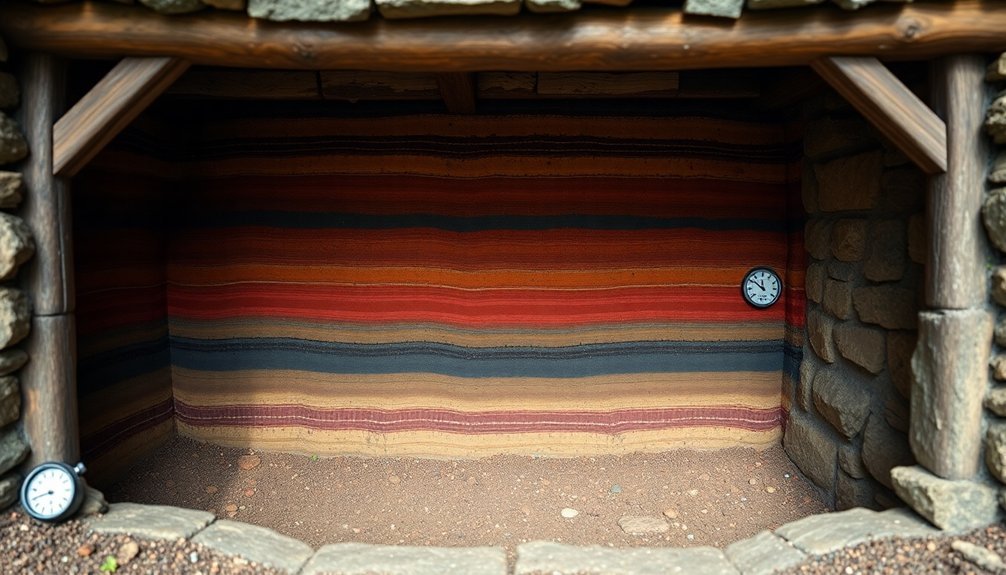



Leave a Reply